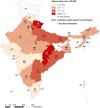Deaths from symptomatically identifiable furious rabies in India: a nationally representative mortality survey
- PMID: 23056661
- PMCID: PMC3464588
- DOI: 10.1371/journal.pntd.0001847
Deaths from symptomatically identifiable furious rabies in India: a nationally representative mortality survey
Abstract
Background: It is estimated that India has more deaths from rabies than any other country. However, existing estimates are indirect and rely on non-representative studies.
Methods and principal findings: We examined rabies deaths in the ongoing Million Death Study (MDS), a representative survey of over 122,000 deaths in India that uses enhanced types of verbal autopsy. We estimated the age-specific mortality rates of symptomatically identifiable furious rabies and its geographic and demographic distributions. A total of 140 deaths in our sample were caused by rabies, suggesting that in 2005 there were 12,700 (99% CI 10,000 to 15,500) symptomatically identifiable furious rabies deaths in India. Most rabies deaths were in males (62%), in rural areas (91%), and in children below the age of 15 years (50%). The overall rabies mortality rate was 1.1 deaths per 100,000 population (99%CI 0.9 to 1.4). One third of the national rabies deaths were found in Uttar Pradesh (4,300) and nearly three quarters (8,900) were in 7 central and south-eastern states: Chhattisgarh, Uttar Pradesh, Odisha, Andhra Pradesh, Bihar, Assam, and Madhya Pradesh.
Conclusions and significance: Rabies remains an avoidable cause of death in India. As verbal autopsy is not likely to identify atypical or paralytic forms of rabies, our figure of 12,700 deaths due to classic and clinically identifiable furious rabies underestimates the total number of deaths due to this virus. The concentrated geographic distribution of rabies in India suggests that a significant reduction in the number of deaths or potentially even elimination of rabies deaths is possible.
Conflict of interest statement
The authors have declared that no competing interests exist.
Figures


References
-
- Fleming G (1872) Rabies and hydrophobia: their history, nature, causes, symptoms, and prevention. London, Chapman and Hall.
-
- Bhishagratna KK (1911) An English translation of the Sushruta Hamsita, Calcutta, Published by the Author.
-
- Sudarshan MK, Madhusudana SN, Mahendra BJ, Rao NS, Ashwath Narayana DH, et al. (2007) Assessing the burden of human rabies in India: results of a national multi-center epidemiological survey. Int J Infect Dis 11 1:29–35. - PubMed
-
- WHO (2002) Rabies vaccines - WHO position paper. Wkly Epidemiol Rec 77: 109–19. - PubMed
Publication types
MeSH terms
Grants and funding
LinkOut - more resources
Full Text Sources
Medical
Research Materials
Miscellaneous

